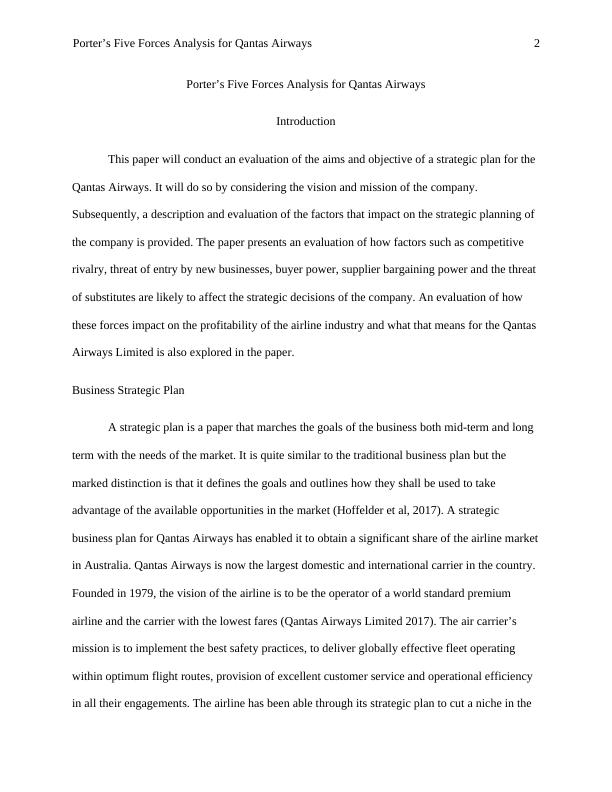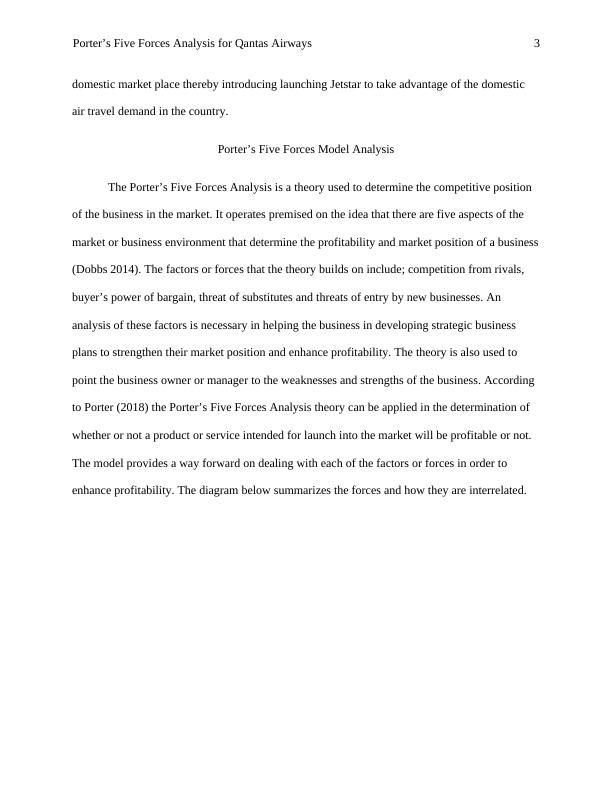Porter’s Five Forces Analysis for Qantas Airways
Added on 2023-06-04
9 Pages2229 Words333 Views
Running head: Porter’s Five Forces Analysis for Qantas Airways 1
Porter’s Five Forces Analysis for Qantas Airways
Name
Institution
Porter’s Five Forces Analysis for Qantas Airways
Name
Institution

Porter’s Five Forces Analysis for Qantas Airways 2
Porter’s Five Forces Analysis for Qantas Airways
Introduction
This paper will conduct an evaluation of the aims and objective of a strategic plan for the
Qantas Airways. It will do so by considering the vision and mission of the company.
Subsequently, a description and evaluation of the factors that impact on the strategic planning of
the company is provided. The paper presents an evaluation of how factors such as competitive
rivalry, threat of entry by new businesses, buyer power, supplier bargaining power and the threat
of substitutes are likely to affect the strategic decisions of the company. An evaluation of how
these forces impact on the profitability of the airline industry and what that means for the Qantas
Airways Limited is also explored in the paper.
Business Strategic Plan
A strategic plan is a paper that marches the goals of the business both mid-term and long
term with the needs of the market. It is quite similar to the traditional business plan but the
marked distinction is that it defines the goals and outlines how they shall be used to take
advantage of the available opportunities in the market (Hoffelder et al, 2017). A strategic
business plan for Qantas Airways has enabled it to obtain a significant share of the airline market
in Australia. Qantas Airways is now the largest domestic and international carrier in the country.
Founded in 1979, the vision of the airline is to be the operator of a world standard premium
airline and the carrier with the lowest fares (Qantas Airways Limited 2017). The air carrier’s
mission is to implement the best safety practices, to deliver globally effective fleet operating
within optimum flight routes, provision of excellent customer service and operational efficiency
in all their engagements. The airline has been able through its strategic plan to cut a niche in the
Porter’s Five Forces Analysis for Qantas Airways
Introduction
This paper will conduct an evaluation of the aims and objective of a strategic plan for the
Qantas Airways. It will do so by considering the vision and mission of the company.
Subsequently, a description and evaluation of the factors that impact on the strategic planning of
the company is provided. The paper presents an evaluation of how factors such as competitive
rivalry, threat of entry by new businesses, buyer power, supplier bargaining power and the threat
of substitutes are likely to affect the strategic decisions of the company. An evaluation of how
these forces impact on the profitability of the airline industry and what that means for the Qantas
Airways Limited is also explored in the paper.
Business Strategic Plan
A strategic plan is a paper that marches the goals of the business both mid-term and long
term with the needs of the market. It is quite similar to the traditional business plan but the
marked distinction is that it defines the goals and outlines how they shall be used to take
advantage of the available opportunities in the market (Hoffelder et al, 2017). A strategic
business plan for Qantas Airways has enabled it to obtain a significant share of the airline market
in Australia. Qantas Airways is now the largest domestic and international carrier in the country.
Founded in 1979, the vision of the airline is to be the operator of a world standard premium
airline and the carrier with the lowest fares (Qantas Airways Limited 2017). The air carrier’s
mission is to implement the best safety practices, to deliver globally effective fleet operating
within optimum flight routes, provision of excellent customer service and operational efficiency
in all their engagements. The airline has been able through its strategic plan to cut a niche in the

Porter’s Five Forces Analysis for Qantas Airways 3
domestic market place thereby introducing launching Jetstar to take advantage of the domestic
air travel demand in the country.
Porter’s Five Forces Model Analysis
The Porter’s Five Forces Analysis is a theory used to determine the competitive position
of the business in the market. It operates premised on the idea that there are five aspects of the
market or business environment that determine the profitability and market position of a business
(Dobbs 2014). The factors or forces that the theory builds on include; competition from rivals,
buyer’s power of bargain, threat of substitutes and threats of entry by new businesses. An
analysis of these factors is necessary in helping the business in developing strategic business
plans to strengthen their market position and enhance profitability. The theory is also used to
point the business owner or manager to the weaknesses and strengths of the business. According
to Porter (2018) the Porter’s Five Forces Analysis theory can be applied in the determination of
whether or not a product or service intended for launch into the market will be profitable or not.
The model provides a way forward on dealing with each of the factors or forces in order to
enhance profitability. The diagram below summarizes the forces and how they are interrelated.
domestic market place thereby introducing launching Jetstar to take advantage of the domestic
air travel demand in the country.
Porter’s Five Forces Model Analysis
The Porter’s Five Forces Analysis is a theory used to determine the competitive position
of the business in the market. It operates premised on the idea that there are five aspects of the
market or business environment that determine the profitability and market position of a business
(Dobbs 2014). The factors or forces that the theory builds on include; competition from rivals,
buyer’s power of bargain, threat of substitutes and threats of entry by new businesses. An
analysis of these factors is necessary in helping the business in developing strategic business
plans to strengthen their market position and enhance profitability. The theory is also used to
point the business owner or manager to the weaknesses and strengths of the business. According
to Porter (2018) the Porter’s Five Forces Analysis theory can be applied in the determination of
whether or not a product or service intended for launch into the market will be profitable or not.
The model provides a way forward on dealing with each of the factors or forces in order to
enhance profitability. The diagram below summarizes the forces and how they are interrelated.

End of preview
Want to access all the pages? Upload your documents or become a member.
Related Documents
Strategic Management.lg...
|7
|1606
|93
Analysis of Porter’s Five Forces of Qantaslg...
|11
|2689
|12
Business Analysis of Qantas Airwayslg...
|13
|2818
|89
Business Analysis and Valuationlg...
|16
|1291
|35
External Environment Analysis of Qantas Airlineslg...
|11
|2403
|211
Qantas Airways: International Strategy Managementlg...
|14
|2982
|233
